World Journal of Mechanics
Vol.2 No.4(2012), Article ID:21537,4 pages DOI:10.4236/wjm.2012.24027
An Analytical Model of the Power Law Distributions in the Complex Network
Uwado-Shinmachi 5-4, Kawagoe-Shi, Japan
Email: coutakagi@mse.biglobe.ne.jp
Received May 25, 2012; revised June 30, 2012; accepted July 12, 2012
Keywords: Complex Networks; Scale Free; Power Law
ABSTRACT
It is known that complex networks in nature exhibit some significant statistical features. We notice power law distributions which frequently emerge with respect to network structures of various quantities. One example is the scale-freeness which is described by the degree distribution in the power law shape. In this paper, within an analytical approach, we investigate the analytical conditions under which the distribution is reduced to the power law. We show that power law distributions are obtained without introducing conditions specific to each system or variable. Conversely, if we demand no special condition to a distribution, it is imposed to follow the power law. This result explains the universality and the ubiquitous presence of the power law distributions in complex networks.
1. Introduction
Various social relations or natural phenomena can be modeled by the network, in which collections of individual components are connected via their interactions. It is known that complex networks exhibit some significant statistical features characterized by quantities such as the clustering coefficient or the degree distribution [1-24]. For example, the numerous studies in this decade have reported the emergence of the scale-freeness in biological, sociological, or technological networks [3-19]. The scalefreeness is defined as the power law shape of the degree distribution
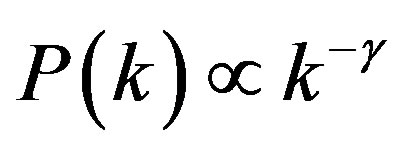 (1)
(1)
with a constant , where the variable
, where the variable  is the degree, the number of links each node has, and
is the degree, the number of links each node has, and 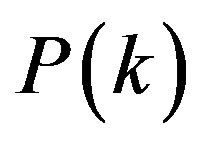 is its distribution function. It is contrasted with the Poisson distribution predicted by the random graph model proposed by the Erdős and Rényi (ER) [25-27].
is its distribution function. It is contrasted with the Poisson distribution predicted by the random graph model proposed by the Erdős and Rényi (ER) [25-27].
One of the fundamental problems regarding statistics of complex networks would be the ubiquity of power laws. The power law distribution can frequently be observed in complex networks with respect to their topological quantities which characterize each network structure. Other than the degree, the betweenness centrality, a topological quantity which depends on the global network structure, gives another example. It has been reported that the cumulative distribution of the betweenness  exhibits the power law in some complex networks [20-22].
exhibits the power law in some complex networks [20-22].
The ubiquitous presence of the power law suggests that simple statistical laws underlie commonly in various types of complex networks. According to the model proposed by Barabási and Albert [3,5], scale free networks are generated through the process named preferential attachment, in which each network node prefers to make a connection to nodes with large degrees. However, taking into account the universality of the power law including the scale-freeness, we can expect that the conditions which allow the emergence of the power law would be given in more generalized forms which are independent to specific systems. In previous studies [23,24], we have introduced an analytical model in which the scale-free degree distribution is reconstructed. Indeed, it has been shown that the scale-free distribution can be obtained without introducing conditions other than general ones. In this paper, in order to extend this model to deal with various types of quantities, we discuss, in detail, required conditions which allow the emergence of the power law distribution. We find that under conditions such as the symmetry with respect to the variable, the power law shape of the distributions can not be obtained. However the distribution which has no such additional condition is naturally reduced to the simple functional form, the power law. Therefore, our result provides an explanation for the ubiquitous presence of the power law.
2. Analytical Framework for Scale-Free Distribution
According to recent studies [23,24] and the framework proposed in them, we show that distributions given in a general form can be reduced to the power law shape without introducing special conditions. We take an analytical approach in the sense that we deal with the degree distribution  as a probability density function defined with a continuous variable.
as a probability density function defined with a continuous variable.
2.1. Basic Notations
Let us take a variable , the degree of each node in the network. We normalize it as
, the degree of each node in the network. We normalize it as , where
, where  is defined in the interval
is defined in the interval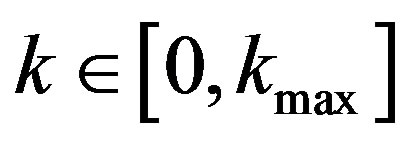 . Then we take the distribution
. Then we take the distribution  with
with  and assume that the variable
and assume that the variable  is a continuous variable defined in the finite interval
is a continuous variable defined in the finite interval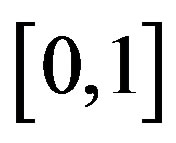 . As a probability, we can demand that
. As a probability, we can demand that  and
and
 , (2)
, (2)
where  is taken in
is taken in .
.  can be expanded with respect to
can be expanded with respect to  in the Taylor series and there exists a representation
in the Taylor series and there exists a representation
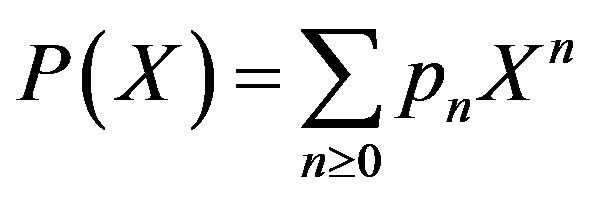 (3)
(3)
with a sequence of coefficients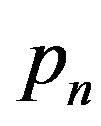 .
.
In order to investigate the scaling behavior of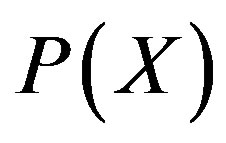 , we introduce the scaling parameter
, we introduce the scaling parameter 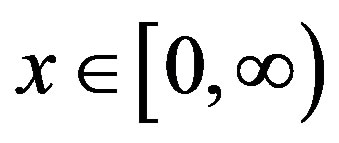 defined as
defined as
 (4)
(4)
in the interval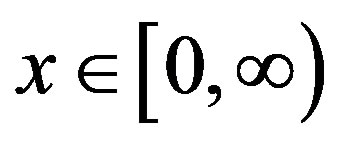 . If we demand the normalizing condition to
. If we demand the normalizing condition to 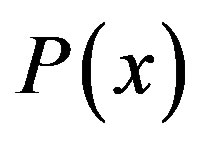
 , (5)
, (5)
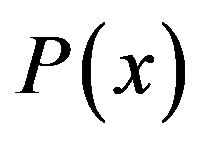 is given as
is given as
 (6)
(6)
by comparing Equations (2) and (5). Furthermore, if we introduce the cumulative distribution 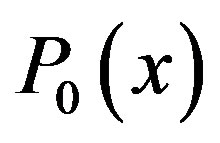
 , (7)
, (7)
then it is given by a positive function  decreasing monotonically with increasing of
decreasing monotonically with increasing of . Then we can represent
. Then we can represent  as
as
 (8)
(8)
with a function  given as an expansion of
given as an expansion of 
 , (9)
, (9)
where the coefficients 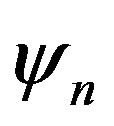 are derived from
are derived from  in Equation (3). With the expression (8), the distribution of
in Equation (3). With the expression (8), the distribution of ,
,  , is given as
, is given as
 . (10)
. (10)
2.2. Scaling Property of P(x)
According to the result shown by the study [23], without introducing additional conditions for 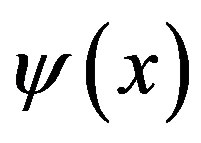 except for
except for
 , (11)
, (11)
we can show that  has a general property given by
has a general property given by
 . (12)
. (12)
At first, taking 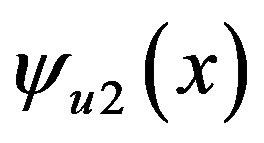 given by
given by
 (13)
(13)
with the terms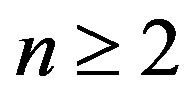 , we decompose
, we decompose  into
into . If we take the average
. If we take the average  by introducing a parameter
by introducing a parameter , it is given by
, it is given by
 . (14)
. (14)
Because Equation (8) defines 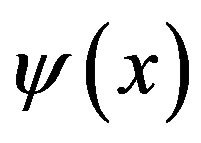 as the scaling for the cumulative distribution,
as the scaling for the cumulative distribution, 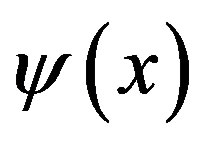 is given as a monotonically increasing function which satisfies the boundary conditions
is given as a monotonically increasing function which satisfies the boundary conditions 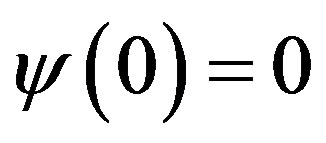 and
and . Then
. Then  satisfies an identical relation given by
satisfies an identical relation given by
 (15)
(15)
where 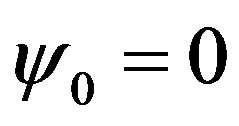 due to the boundary conditions of
due to the boundary conditions of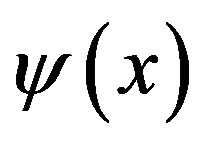 . Also we can have another relation
. Also we can have another relation
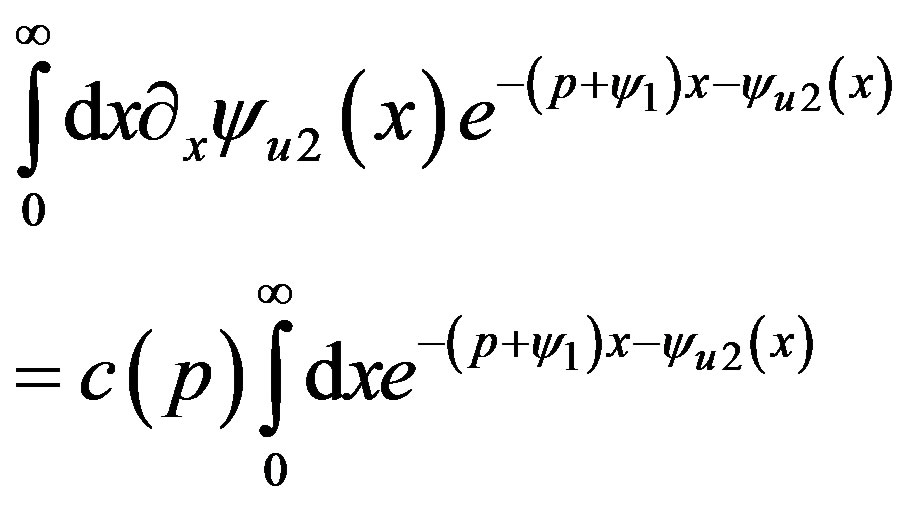 (16)
(16)
with a function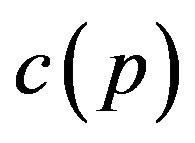 , because integrals on each side give functions of
, because integrals on each side give functions of  respectively. Combining these relations (15) and (16), we obtain the relation
respectively. Combining these relations (15) and (16), we obtain the relation
 . (17)
. (17)
Because the left-hand side can be regarded as the Laplace transform with a parameter ,
,  is uniquely determined as the inverse transform of the right-hand side. Then we obtain
is uniquely determined as the inverse transform of the right-hand side. Then we obtain
 . (18)
. (18)
However, because the coefficient for  in
in  expansion is taken to be 0 and the expansion
expansion is taken to be 0 and the expansion  is free from
is free from , it is required that
, it is required that
 (19)
(19)
and Equation (12) is given.
2.3. A Class of Distributions and the Power Law
The degree distribution 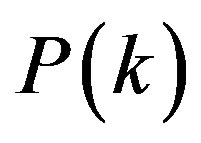 is derived from
is derived from 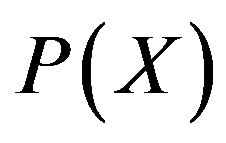 with embedding from the degree
with embedding from the degree  to the continuous variable
to the continuous variable Substituting the representation (12),
Substituting the representation (12), 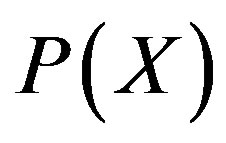 is given in the power law shape,
is given in the power law shape,
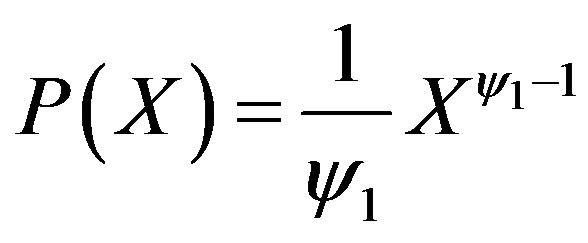 , (20)
, (20)
with a constant  and substituting
and substituting  straightforwardly gives the expression of
straightforwardly gives the expression of  in the power law shape.
in the power law shape.
However, the relation between  and
and  is not determined uniquely. Indeed, besides a trivial relation such as
is not determined uniquely. Indeed, besides a trivial relation such as  with the maximum value of
with the maximum value of ,
,  , we can take arbitrary transforms from
, we can take arbitrary transforms from  to
to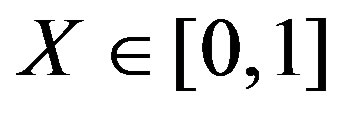 . Then we show that distributions which satisfy the condition (11) comprise a class of distributions. Within this class, the basic property (12) is conserved under the transforms between distributions.
. Then we show that distributions which satisfy the condition (11) comprise a class of distributions. Within this class, the basic property (12) is conserved under the transforms between distributions.
Let us take normalized variables  and
and 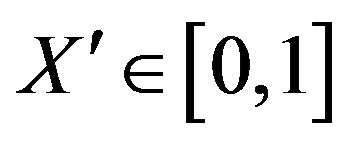 and consider transforms
and consider transforms . Generally these transforms are given by the polynomial
. Generally these transforms are given by the polynomial
 (21)
(21)
of  with coefficients
with coefficients . At first, if we apply our calculating procedure to
. At first, if we apply our calculating procedure to , then
, then  is given in the power law functional form such as Equation (20). However substituting Equation (21) gives
is given in the power law functional form such as Equation (20). However substituting Equation (21) gives 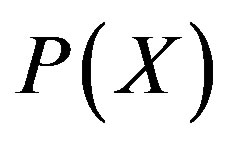 form by
form by
 (22)
(22)
with another constant . Comparing this Equation (22) to Equation (20), we find that transforms from
. Comparing this Equation (22) to Equation (20), we find that transforms from  to
to  are represented by the single term expansions such as
are represented by the single term expansions such as
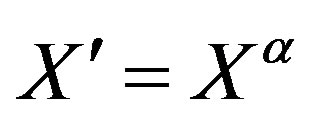 (23)
(23)
with a constant . Under these transforms, distributions comprise a class that preserves the power law.
. Under these transforms, distributions comprise a class that preserves the power law.
3. Conditions for the Power Law Distribution
In the previous section, we have shown that the distribution  is imposed to follow the power law shape if
is imposed to follow the power law shape if  satisfies the general condition
satisfies the general condition 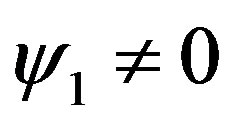 given by Equation (11). In this section, we investigate this condition in more detail.
given by Equation (11). In this section, we investigate this condition in more detail.
As we have shown in the previous section, under the condition (11), distributions comprise a general class of distributions which follow the power law. As an example of exceptional cases, we construct different types of distributions which are excluded from this class. Introducing a different condition to the distribution, we show the existence of a distribution class which includes the Gaussian distribution.
As well known, the Gaussian distribution follows a profile different from the power law. As an example of a different class of distribution, we consider the following case to which we can not apply our framework. Let us take a variable  with a distribution
with a distribution 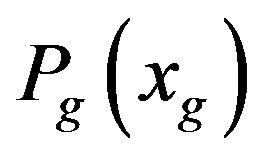 and assume that it satisfies the condition
and assume that it satisfies the condition
 . (24)
. (24)
If we represent  as
as
 (25)
(25)
with an expanded expression
 , (26)
, (26)
then 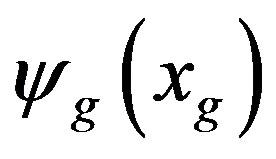 has the coefficients
has the coefficients
 (27)
(27)
due to the condition (24).
In this case we can not apply our framework given in the previous section and the probability density function  is not included in the class of distributions which follow the power law. Within the distribution class we defined in the previous section, each element is related by the transform represented by Equation (23) and the power law feature is conserved under these transforms. However, the functional form (26) with coefficients (27) can not be reduced to the power law due to the condition (11). On the other hand, the Gaussian distribution, for example, explicitly has the symmetry such as given by Equation (24). Then there exists no transform which relates the Gaussian distribution and the power law distribution.
is not included in the class of distributions which follow the power law. Within the distribution class we defined in the previous section, each element is related by the transform represented by Equation (23) and the power law feature is conserved under these transforms. However, the functional form (26) with coefficients (27) can not be reduced to the power law due to the condition (11). On the other hand, the Gaussian distribution, for example, explicitly has the symmetry such as given by Equation (24). Then there exists no transform which relates the Gaussian distribution and the power law distribution.
In this example, the symmetry of the distribution, Equation (24), breaks the condition for the power law, Equation (11). According to our result, the power law emerges as a primitive common feature of distributions. However characteristics of each system such as the symmetry of the variable work as additional conditions to the distribution and break this law.
4. Concluding Remarks
As we have discussed, our framework predicts the emergence of the power law distribution when the variable satisfies the general analytical conditions. Our model does not depend on specific systems and therefore we can apply our framework to describe the statistical behavior of various variables other than the degree. Our result suggests that the power law distribution is a ubiquitous functional form in real world networks. Then we can expect that our model provides one description which allows us to deal with various types of complex networks and their statistical quantities in a unified framework.
REFERENCES
- D. J. Watts and S. H. Strogatz, “Collective Dynamics of ‘Small-World’ Networks,” Nature, Vol. 393, No. 6684, 1998, pp. 440-442. doi:10.1038/30918
- S. H. Strogatz, “Exploring Complex Networks,” Nature, Vol. 410, No. 6825, 2001, pp. 268-276. doi:10.1038/35065725
- A.-L. Barabási and R. Albert, “Emergence of Scaling in Random Networks,” Science, Vol. 286, No. 5439, 1999, pp. 509-512. doi:10.1126/science.286.5439.509
- A.-L. Barabási, R. Albert, and H. Jeong, “Mean-Field Theory for Scale-Free Random Networks,” Physica A, Vol. 272, No. 1-2, 1999, pp. 173-187. doi:10.1016/S0378-4371(99)00291-5
- P. L. Krapivsky, S. Redner and F. Leyvraz, “Connectivity of Growing Random Networks,” Physical Review Letters, Vol. 85, No. 21, 2000, pp. 4629-4632. doi:10.1103/PhysRevLett.85.4629
- S. N. Dorogovtsev, J. F. F. Mendes and A. N. Samukhin, “Structure of Growing Networks with Preferential Linking,” Physical Review Letters, Vol. 85, No. 21, 2000, pp. 4633-4636. doi:10.1103/PhysRevLett.85.4633
- A. Broder, R. Kumar, F. Maghoul, P. Raghavan, S. Rajagopalan, R. Stata, A. Tomkins and J. Wiener, “Graph Structure in the Web,” Computer Networks, Vol. 33, No. 1-6, 2000, pp. 309-320. doi:10.1016/S1389-1286(00)00083-9
- M. Faloutsos, P. Faloutsos and C. Faloutsos, “On PowerLaw Relationships of the Internet Topology,” ACM SIGCOMM—Computer Communication Review, Vol. 29, No. 4, 1999, pp. 251-262. doi:10.1145/316194.316229
- S. N. Dorogovtsev and J. F. F. Mendes, “Evolution of Networks,” Advances in Physics, Vol. 51, No. 4, 2002, pp. 1079-1187. doi:10.1080/00018730110112519
- R. Albert and A.-L. Barab’asi, “Statistical Mechanics of Complex Networks,” Reviews of Modern Physics, Vol. 74, No. 1, 2002, pp. 47-97. doi:10.1103/RevModPhys.74.47
- M. E. J. Newman, “The Structure and Function of Complex Networks,” SIAM Review, Vol. 45, No. 2, 2003, pp. 167-256. doi:10.1137/S003614450342480
- R. Albert, H. Jeong and A.-L. Barabási, “Internet: Diameter of the World-Wide Web,” Nature, Vol. 401, No. 6749, 1999, pp. 130-131. doi:10.1038/43601
- M. E. J. Newman, “Scientific Collaboration Networks. I. Network Construction and Fundamental Results,” Physical Review E, Vol. 64, No. 1, 2001, Article ID: 016131. doi:10.1103/PhysRevE.64.016131
- H. Jeong, B. Tombor, R. Albert, Z. N. Oltvai and A.-L. Barabási, “The Large-Scale Organization of Metabolic Networks,” Nature, Vol. 407, No. 6804, 2000, pp. 651- 654. doi:10.1038/35036627
- H. Jeong, S. Mason, A.-L. Barabási and Z. N. Oltvai, “Lethality and Centrality in Protein Networks,” Nature, Vol. 411, No. 6833, 2001, pp. 41-42. doi:10.1038/35075138
- O. Sporns, D. R. Chialvo, M. Kaiser and C. C. Hilgetag, “Organization, Development and Function of Complex Brain Networks,” Trends in Cognitive Sciences, Vol. 8, No. 9, 2004, pp. 418-425. doi:10.1016/j.tics.2004.07.008
- E. Bullmore and O. Sporns, “Complex Brain Networks: Graph Theoretical Analysis of Structural and Functional Systems,” Nature Reviews Neuroscience, Vol. 10, No. 3, 2009, pp. 186-198. doi:10.1038/nrn2575
- J. A. Dunne, R. J. Williams and N. D. Martinez, “FoodWeb Structure and Network Theory: The Role of Connectance and Size,” Proceedings of the National Academy of Sciences, Vol. 99, No. 20, 2002, pp. 12917-12922. doi:10.1073/pnas.192407699
- M. C. Gonz’alez, C. A. Hidalgo and A.-L. Barabási, “Understanding Individual Human Mobility Patterns,” Nature, Vol. 453, No. 7196, 2008, pp. 779-782. doi:10.1038/nature06958
- A. Vazquez, R. Pastor-Satorras and A. Vespignani, “LargeScale Topological and Dynamical Properties of the INTERNET,” Physical Review E, Vol. 65, No. 6, 2002, Article ID: 066130. doi:10.1103/PhysRevE.65.066130
- R. Albert, I. Albert and G. L. Nakarado, “Structural Vulnerability of the North American Power Grid,” Physical Review E, Vol. 69, No. 2, 2004, Article ID: 025103(R). doi:10.1103/PhysRevE.69.025103
- R. Guimer’a, S. Mossa, A. Turtschi and L. A. N. Amaral, “The Worldwide Air Transportation Network: Anomalous Centrality, Community Structure, and Cities’ Global Roles,” Proceedings of the National Academy of Sciences of the United States of America, Vol. 102, No. 22, 2005, pp. 7794-7799. doi:10.1073/pnas.0407994102
- K. Takagi, “Scale Free Distribution in an Analytical Approach,” Physica A: Statistical Mechanics and Its Applications, Vol. 389, No. 10, 2010, pp. 2143-2146. doi:10.1016/j.physa.2010.01.034
- K. Takagi, “An Analytical Approach for Degree Correlations in Complex Network,” World Journal of Mechanics, Vol. 2, No. 2, 2012, pp. 171-174. doi:10.4236/wjm.2012.23020
- P. Erdős and A. Rényi, “On Random Graphs,” Publicationes Mathematicae, Vol. 6, 1959, pp. 290-297.
- P. Erdős and A. Rényi, “On the Evolution of Random Graphs,” Publications of the Mathematical Institute of the Hungarian Academy of Sciences, Vol. 5, 1960, pp. 17-61.
- P. Erdős and A. Rényi, “On the Strength of Connectedness of a Randomgraph,” Acta Mathematica Scientia Hungary, Vol. 12, No. 1-2, 1961, pp. 261-267. doi:10.1007/BF02066689

